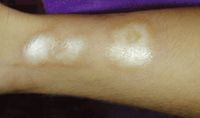Skin tightens, then darkens and thickens, in a 7-year-old
Purple and swollen skin becomes dark and thickened in a healthy 7-year-old girl.
KELLY ECKER, DO

Diagnosis: Morphea
Clinical findings

In localized morphea, one to three round or oval, 2-to 5-cm-in-diameter, circumscribed plaques typically develop on the trunk. The lesions often begin as erythematous and edematous patches or plaques with overlying telangiectasia that, over a few weeks or months, enlarge and become shiny and firm indurated plaques. These lesions may demonstrate varying hypopigmentation and hyperpigmentation and a shiny surface that results from epidermal atrophy and loss of hair follicles and sweat ducts. Over months or even several years, the skin usually softens and pigmentary changes improve.
In generalized morphea, large plaques become confluent over large areas of the trunk and extremities.
In linear morphea, long, thin plaques develop unilaterally along the extremities and on the scalp and trunk. Collagen deposition may extend deeply into underlying soft tissue and bone. When lesions extend over a joint, contractures may develop.
The en coup de saber variant involves the scalp and face and may cause hemiatrophy, with soft-tissue and neurologic complications.
Although morphea is usually asymptomatic, painful ulcers can develop, particularly over areas of trauma. In addition, severe restriction of range of motion can occur around joints.
Pathogenesis
The cause of morphea is unknown, although an autoimmune process triggered by environmental factors in genetically predisposed persons is suspected. Infection-including by Epstein-Barr virus, varicella, measles, and Borrelia burgdorferi-has been reported to precede the onset of morphea, but a causative role for these pathogens has not been confirmed. Trauma and radiation have also been reported to trigger new-onset morphea or new lesions in patients in whom disease is established.
Differential diagnosis
Although cutaneous findings of morphea are usually distinctive, they may be confused with acrodermatitis chronica atrophicans, lichen sclerosus, graft-versus-host disease, porphyria cutanea tarda, and hypertrophic scarring from chemical, mechanical, and thermal trauma. In fact, considerable clinical and histologic overlap with lichen sclerosus and graft-versus-host disease suggests a pathogenetic relationship between morphea and these disorders.
How to evaluate
A diagnosis of morphea can usually be made clinically, although skin biopsy is often useful to confirm the diagnosis-especially when classic findings are absent. A test of antinuclear antibody is positive in 45% to 80% of cases. Tests of anti-single-stranded DNA antibody and anti-histone antibody may also be positive.
Treatment, prognosis
A number of therapies have been tried for morphea:
Morphea usually follows a self-limited course in which improvement is seen over three to five years. Patients do require serial monitoring, however, at three-to-six-month intervals, to assess any progression of cutaneous findings; those who are being treated for active disease should be seen more often.
SUGGESTED READING
Brenner M, Herzinger T, Berking C, et al: Phototherapy and photochemotherapy of sclerosing skin diseases. Photodermatol Photoimmunol Photomed 2005;21:157
Dervis E, Dervis E: Progressive hemifacial atrophy with linear scleroderma. Pediatr Dermatol 2005;22:436
Kreuter A, Gambichler T, Breuckmann F, et al: Pulsed high-dose corticosteroids combined with low-dose methotrexate in severe localized scleroderma. Arch Dermatol 2005;141:847
Salpietro D, Merlino M, Bruglia S, et al: Linear scleroderma en coup de sabre associated with facial atrophy in a patient with seropositive Borrelia burgdorferi: A true case of molecular mimicry? Pediatr Allerg Immunol 2004;15:570
Sato S, Kodera M, Hasegawa M, et al: Antinucleosome antibody is a major autoantibody in localized scleroderma. Br J Dermatol 2004;151:1182
Please see Dr. Cohen's Web site, http://www.dermatlas.org/, for additional images
Recognize & Refer: Hemangiomas in pediatrics
July 17th 2019Contemporary Pediatrics sits down exclusively with Sheila Fallon Friedlander, MD, a professor dermatology and pediatrics, to discuss the one key condition for which she believes community pediatricians should be especially aware-hemangiomas.